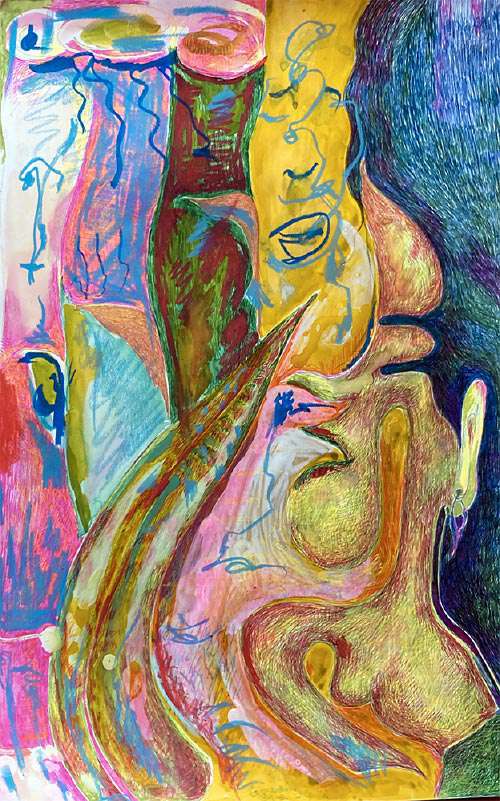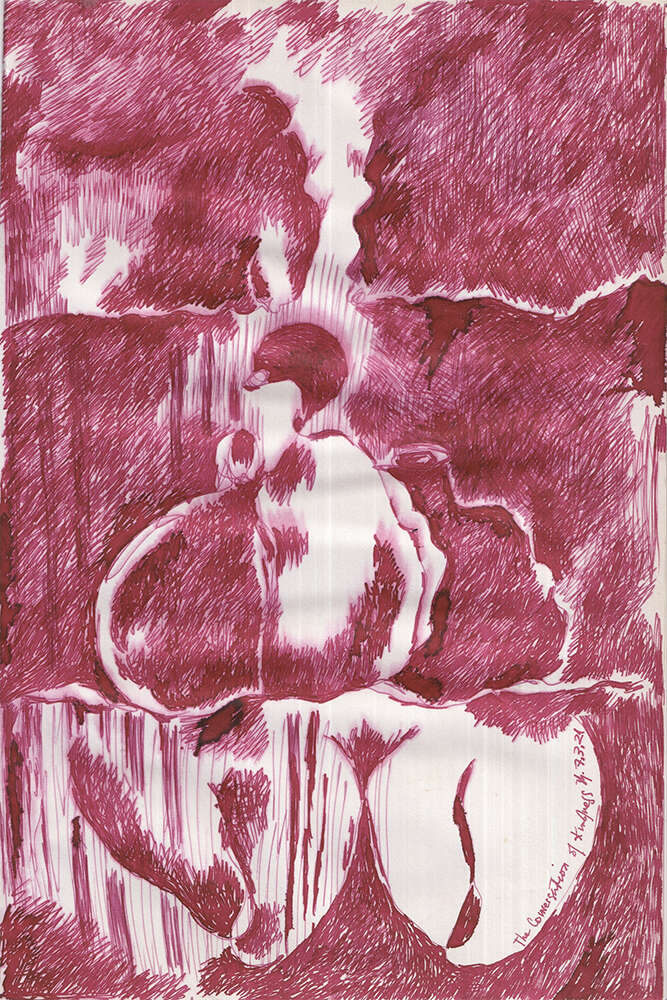Drawing - A place of the most erotic
An interview with Zari Harat
Susanne: I am very happy that you would like to contribute to our magazine. I would like to speak first about the two pictures. In what context were these two pictures created?
Zari: These pictures were created in 2021. The first piece is called “Conversation with E”, and the second piece is, “The Conversation of Kindness”. These are two different pieces that deal with the intimacy of yourself, getting to know yourself. That also has a lot to do with how we are able to craft our eroticism into our lives. When an artist creates something, they must go to that place which is most erotic, most integral, most intimate to let something go. When you are learning to draw, you learn to touch the world around you, perhaps maybe in the way you touch another person or might touch yourself.
Susanne: A way of self-reflection is being intimate with oneself and the world.
Zari: When you are intimate with yourself, you can be intimate with others. A lot of people are looking for their intimacy outside of themselves, for outer recognition and gratification. My thesis is that it must first come from within you, in order for you to experience it. One of the important things is how the things that can be touched can be visualised and how they can change the world around you.

Susanne: The first picture has a lot of yellow. Do you think it is a pansexual colour?
Zari: I think you need yellow to bring people together. There are lot of yellows and different colours and layering in here, in this piece. It’s like a conversation with a person that you are just trying to get to know. Each drawing is like a new relationship. You have to come clean with yourself, you just have to open yourself up, to open up possibilities. You have to first become a friend with yourself and then with that person or group of people. I understand the aspect of pansexuality but it’s actually about gender fluidity. Because I think everybody can have those types of colours in their lives and those gestures, if they can just manage to be still and feel themselves.
Susanne: What do you mean by gender fluidity?
Zari: We are living in a world, where we put people into boxes too often. Let me give an example: I give drawing classes and somebody who had a show in New York said, “do you accept me as a man or as a woman” and I said, “I accept you as who you are accepting yourself as. Who am I to define you? You must find that in yourself”.
Susanne: If there is fluidity, then what is identity based on?
Zari: It’s femininity that everybody embodies. If you run from your femininity, then you run from yourself. I think we all have levels of femininity to express, whether we identify as non-binary or not. If you really accept yourself, then you can accept whoever comes to you. We all have our feminine and masculine sides in us. Some do suppress it because they are taught in their societies that they are not supposed to live it out. When you have a conversation with somebody and you don’t expect anything, you can discover the most surprising aspects of what life is all about. If you look at the love of Josephine Baker and Frieda Kahlo, they are exploring conversations. It’s about beginning to communicate with the world around you that wakes you up and takes you to amazing places.
Susanne: It’s about the essence of human beings of being ever and always social.
Zari: If you are true to yourself and to your nature, then you can be true to the world around you. Often, we are people who blind others and do not communicate, because we think we’re judging ourselves and that others judge us. Julia Cameron, in her book “The Artist’s Way” spoke about the broken artist and I see so many broken artists around me and because of the lockdown, they come to my drawing classes and want to utter and visualise what is inside of them and they have lots of stories to tell. But they are afraid of their own intimacy with themselves and the world around them, because the society we live in does not let them look at that.

Susanne: And there your teaching has also become very political, I guess.
Zari: Yes, very political. It is almost sensual, because its asks people to go inside and look at who we really are and take those pictures from inside and put them onto paper or a canvas or into a song. Most people did not grow up in a world where it was accepted to find out who they are regarding their sexuality and their creativity. These are the hidden spaces that people could just look at now.
Susanne: Art also as an expression of the unconsciousness or the unconscious erotic?
Zari: Well, it’s right there. I ask people about their own stories. I might put some music on or give them the space to look at images. From our conversations, I just ask them to draw what they feel. It creates a safe space to be yourself and then we come back and look at that again. A lot of people tell me things they would probably never tell anybody. It creates a safe space to find out what that is. I do that in my own artwork and that is what I give as a present to others.
Susanne: Have you experienced that people relate to others by a false self, a term introduced by the British psychoanalyst Donald Winnicott? So, art is a means of getting closer to the authentic self?
Zari: Most people grow up in a world, where they were little children, where their parents might have said, that they can draw a little bit, but as they got older, it was less important. Drawing is a form of note taking to find out who you are and being authentic with yourself. The false self is perhaps the broken artist that everybody has within them, but it has been so suppressed (it even has greater worth than coming out in their sexual identity), so that most people have a hard time coming out to their own creativity. Max Beckmann for example had a lot of struggle with that. But he showed it in his work, Frieda Kahlo showed it in her work. Amrit Sher Gil showed it in her sensuality where in one world she was very Indian (her father was Punjabi), and in the other world she was very German and Hungarian. In an art school, you learn this. It’s like in writing, it’s a craft. You learn how to take who you are and work with it. I can choose different forms of canvas or paper. I can choose different mediums. They are my literacy.
Susanne: Thank you very much for your time.
Write comment
Your email address will not be published. Comments are published only after moderation.
Comments ()